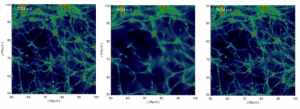A wealth of observational evidence indicates that the mass-energy density of the Universe is in some exotic, dark, form, unlike the ordinary baryonic matter of everyday experience. The currently favoured Lambda Cold Dark Matter (LCDM) theory of cosmology tells us that dark matter shapes the large-scale structure of the Universe and defines the regions within which galaxies form, while dark energy drives the accelerated present-day cosmic expansion. Sophisticated supercomputer simulations and galaxy formation models reveal that the predictions of the LCDM model are in broad agreement with observations, but the challenge is to devise sensitive and robust tests that can discriminate between the favoured model and plausible alternatives. Our work encompasses a number of key areas, including;
- establishing accurate predictions for structure formation in dark matter models, ranging from the favoured Cold Dark Matter (CDM) model to the Warm Dark Matter and Self-Interacting Dark Matter variants;
- developing robust statistical measures of cosmic structure to quantify differences between cosmological models; and
- motivating observing strategies to test dark matter with next generation galaxy surveys.
The prospective student can get involved in various aspects of this broad research area, including:
- Exploring how satellite galaxy dynamics are influenced by a galaxy’s assembly history and its larger-scale environment, and how this impacts estimate of halo mass.
- Modelling stellar shells, streams, and halos to place limits on the dark matter distribution in and around galaxies.
- Developing new algorithms to improve the accuracy of cosmological N-body simulations of non-standard dark matter models.
- Deducing model-independent constraints on the smoothness of dark matter halos using combined datasets.
- Combining alternative cosmologies N-body simulations with semi-analytic models of galaxy formation.

Three numerical simulations of the distribution of dark matter in cold, warm or self-interacting dark matter (left to right). Credit: Chris Power.